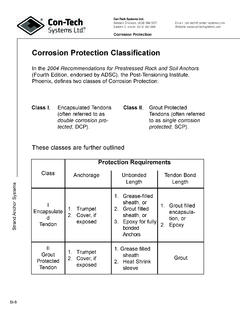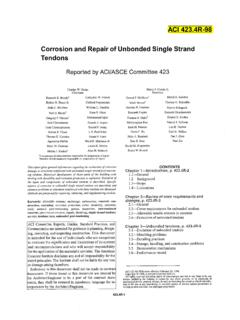Transcription of Anchoring: How much anchor line should you let …
1 anchoring : How much anchor line should you let out? By Ed Bottrell, SMSC Vice Commodore and CYA Sr. Cruising & Powerboat Instructor Simply put, it depends on how deep the water is and the expected conditions. Here are some simple rules of thumb : Short term (lunch) in calm conditions 3:1 (length of rode to depth of water)Overnight in normal conditions 5:1 Overnight or unattended in potential storm conditions 7:1 The ratio of the length of rode to the depth of water is called the scope, which should increase as we prepare for worsening conditions. The larger the scope, the better the anchor will hold because the angle of pull is just a few degrees off the bottom. However, with scope greater than 10:1 this angle will not change very much . The depth of water is not just the charted depth, but also includes the depth at high tide, and the vertical distance from the waterline to the anchor chock on the boat. If you expect a storm surge or the anchor to dig in quite a bit, add those amounts too.
2 So if the chart depth at your anchorage is 3m (about 10 ), expected high tide 2m (about 6 ) and height to the anchor chock is (about 4 ), then the total depth for scope calculation is or 20 , which yields an answer of or 105 for a normal overnight anchorage. These best practices also assume you have an adequate anchor type and size. In Nova Scotia waters, most cruisers use a CQR/Plow, Bruce or Fisherman s anchor . The size/weight should be matched to the boat and, of course, bigger is better assuming you, your crew and boat can handle the weight. I also recommend an anchor buoy with trip line attached to the crown of the anchor in case you need to pull it out backwards. The best rode is 3 strand nylon primarily because of its strength and ability to stretch (up to 20% or so). Double braided nylon is OK but may wear faster and not have as much strength. It s a good idea to have 10 20 of chain at the anchor end of the rode. Although this adds to the weight that you have to pull up, it also provides greater holding power (about times) and contributes to the shock absorption in modest wind and wave conditions.
3 Another technique to achieve better holding power is the use of a kellet, which is a weight that is slid down the anchor rode on a separate line . It should be slid down at least half way and ideally most of the way to the anchor then, as the boat pulls on the anchor rode, the kellet acts as an additional weight and shock absorber. The use of a kellet and some chain effectively triples (about ) the holding power of just nylon rode. All chain ( BBB or high test) is best but not practical unless you have a windlass and a boat that can handle the weight of the anchor and chain in the bow. All chain effectively increases holding power by almost 8 times that of just 3 strand nylon rode. In gale force winds and stronger, the rode is stretched tight most of the time anyhow and the natural bend of the anchor line ( catenary) is lost. Further, the force of the wind on the boat (windage) quadruples when the speed of the wind doubles. If you are expecting gale force (34 40 kt) or stronger winds, you should use other contingency plans such as multiple anchors.
4





